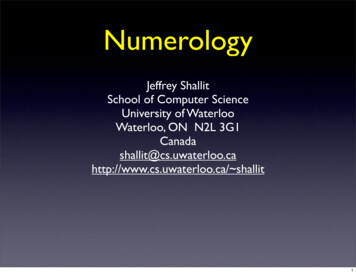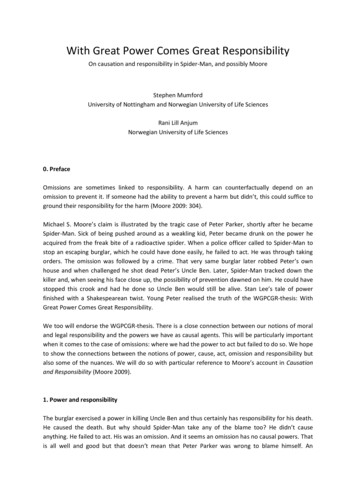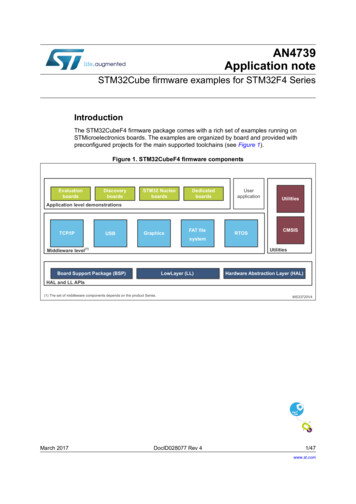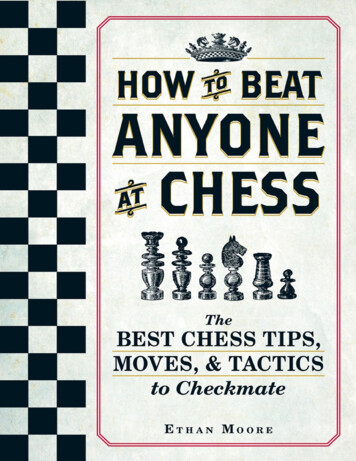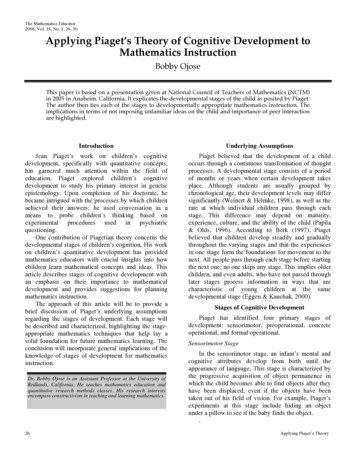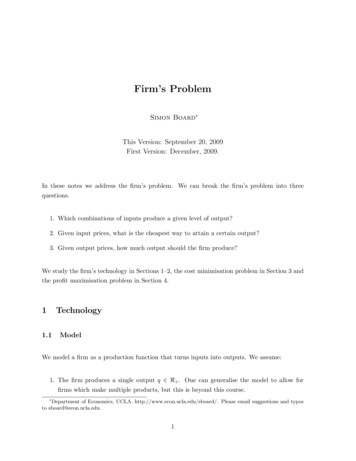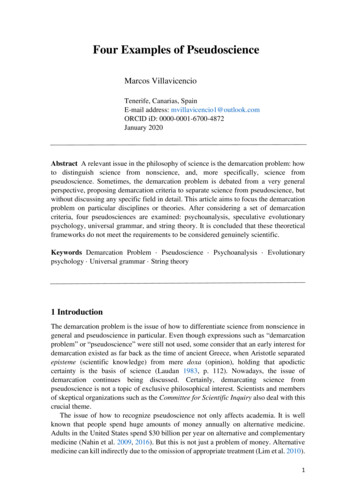
Transcription
Four Examples of PseudoscienceMarcos VillavicencioTenerife, Canarias, SpainE-mail address: mvillavicencio1@outlook.comORCID iD: 0000-0001-6700-4872January 2020Abstract A relevant issue in the philosophy of science is the demarcation problem: howto distinguish science from nonscience, and, more specifically, science frompseudoscience. Sometimes, the demarcation problem is debated from a very generalperspective, proposing demarcation criteria to separate science from pseudoscience, butwithout discussing any specific field in detail. This article aims to focus the demarcationproblem on particular disciplines or theories. After considering a set of demarcationcriteria, four pseudosciences are examined: psychoanalysis, speculative evolutionarypsychology, universal grammar, and string theory. It is concluded that these theoreticalframeworks do not meet the requirements to be considered genuinely scientific.Keywords Demarcation Problem · Pseudoscience · Psychoanalysis · Evolutionarypsychology · Universal grammar · String theory1 IntroductionThe demarcation problem is the issue of how to differentiate science from nonscience ingeneral and pseudoscience in particular. Even though expressions such as “demarcationproblem” or “pseudoscience” were still not used, some consider that an early interest fordemarcation existed as far back as the time of ancient Greece, when Aristotle separatedepisteme (scientific knowledge) from mere doxa (opinion), holding that apodicticcertainty is the basis of science (Laudan 1983, p. 112). Nowadays, the issue ofdemarcation continues being discussed. Certainly, demarcating science frompseudoscience is not a topic of exclusive philosophical interest. Scientists and membersof skeptical organizations such as the Committee for Scientific Inquiry also deal with thiscrucial theme.The issue of how to recognize pseudoscience not only affects academia. It is wellknown that people spend huge amounts of money annually on alternative medicine.Adults in the United States spend 30 billion per year on alternative and complementarymedicine (Nahin et al. 2009, 2016). But this is not just a problem of money. Alternativemedicine can kill indirectly due to the omission of appropriate treatment (Lim et al. 2010).1
Trends based on pseudoscientific beliefs, such as the anti-vaccination movement and HIVdenialism, have clear negative consequences for the population. It is so important toanalyze science as it is to scrutinize its imitation. Pseudoscience is a complex andinfluential phenomenon in society. Therefore, the demarcation problem is a theoreticalmatter with practical implications.Given the fact that pseudoscience is relatively common in the non-scientificenvironment, it is unsurprising that pseudoscience also proliferates in academia. Thescientific community adopts a tacit methodological skepticism—theories are generallynot accepted without solid empirical evidence. However, sometimes unscientificapproaches emerge in a science and start to be gradually accepted. In some cases, it isrelatively easy to separate scientific practices from non-scientific ones. For example,there is wide consensus in the scientific community that parapsychology, scientificcreationism, intelligent design, graphology or homeopathy are pseudoscientific practices.Hansson (2013, chap. 4) considers that for scientists it is generally as easy to distinguishscience from pseudoscience as it is to ride a bicycle: it is a form of tacit knowledge,something that cannot be fully explained in explicit terms but it is easy to execute.Nonetheless, in certain cases it is more complicated to determine whether a discipline isscientific or not. In effect, some disciplines have created a long debate on itsepistemological status since its conception.This paper discusses the general aspects of the demarcation problem (section 2) aswell as some of the pseudoscientific practices that have emerged in the past decades. Inparticular, four theoretical frameworks are analyzed: psychoanalysis (Section 3),speculative evolutionary psychology (Section 4), universal grammar (section 5) andstring theory (section 6).2 Demarcation ProblemThe purpose of this section is to present and discuss the basics of the demarcationproblem. Section 2.1 briefly describes some perspectives of the philosophers of scienceon the demarcation problem, including Popper’s notion of falsifiability and the puzzlesolving criterion adopted by Kuhn. In section 2.2 the validity of four demarcation criteriais defended.2.1 Historical contextThe first to use the expression “demarcation problem” in the philosophy of science wasKarl Popper. According to Popper himself, he started to ponder the demarcation problemin 1919, when he was only 17 years old (Popper 1962, p. 33). Popper employed the term“demarcation problem” to denote the matter of how to distinguish science frompseudoscience and metaphysics (Popper 1959/2002, p. 11, 1962, p. 33).Popper proposed a new criterion to separate science from pseudoscience: the criterionof falsifiability. Popper argued that theories must be falsifiable to achieve scientific status.A theory is falsifiable if it can be refuted by experience (Popper 1959/2002, p. 18).Theories that cannot be refuted by counterexamples are untestable (or unfalsifiable, orirrefutable) (Popper 1962, p. 37).For Popper, supporting evidence is the result of genuine attempts to test a theory, thatis, unsuccessful attempts to falsify it (1962, p. 36). Popper (1983, p. xx) cited Einstein’s2
equivalence principle as an example of falsifiable hypothesis, since it can potentially becontradicted with several observations or experiments. Importantly, Popper (1962, p. 37)classified as unfalsifiable those theories that introduce ad hoc reinterpretations or excusesto avoid refutation when counterexamples appear. Thus, Popper considered thatastrology, the Marxist theory of history and psychoanalysis are not refutable, thereforeunscientific.The historian and philosopher of science Thomas Kuhn was also interested in thedemarcation debate. To differentiate science from pseudoscience, Kuhn proposed thepuzzle-solving criterion: a paradigm or theoretical framework is scientific if it solvespuzzles and it is unscientific if it does not solve puzzles. In his famous book The structureof scientific revolutions, he described puzzles in the following manner: “Puzzles are, inthe entirely standard meaning here employed, that special category of problems that canserve to test ingenuity or skill in solution” (Kuhn 1970b, p. 36). In this context, puzzlesare the problems that scientists face in normal or established science, such as closing thegap between observations and theoretical predictions (Marcum 2005, pp. 63-64). In a lateressay, Kuhn (1970a) compared astronomy with astrology and concluded that astrology“had no puzzles to solve and therefore no science to practice” (p. 9). Kuhn (1970a) heldthat astronomers are engaged in puzzle-solving when they re-examine their theories as aconsequence of unexpected observations, while astrologers are not involved in researchpuzzles since they never “attempt to revise the astrological tradition” (p. 9).A serious objection to the puzzle-solving criterion is that some theoretical frameworkscan solve puzzles despite not being falsifiable (e.g., universal grammar, as discussed insection 5.9). It is therefore a redundant criterion, since some theoretical frameworks cansolve puzzles without being falsifiable, but no theory can be falsifiable without solvingpuzzles, so with falsifiability the puzzle-solving criterion becomes unnecessary.Kuhn criticized Popper’s notion of falsifiability. He considered that falsification doesnot occur with a refuting or falsifying instance, but with the replacement of a new theoryor paradigm over the old one. Thus, according to (Kuhn 1970b) falsification “consists inthe triumph of a new paradigm over the old one” (p. 147). The main problem is that Kuhndoes not separate two related but different concepts: (1) replacement and (2) refutation.The fact that a paradigm has been replaced does not always imply that it has been refutedor falsified. For instance, psychoanalysis has been replaced by other frameworks inpsychology but not fully falsified, since it is a discipline largely unfalsifiable (as discussedin section 2). Behaviorism was also largely replaced by cognitivism during the cognitiverevolution that began in the mid-1950s, without being totally refuted. The principles ofbehaviorism remain particularly useful for clinical psychology under cognitivebehavioral therapy. In sum, the reason why a theoretical framework is unfalsifiable isbecause it is formulated in a way that avoids refutation, not because it does not allow newparadigms or theories.Popper and Kuhn put, respectively, a single demarcation criterion: falsifiability andpuzzle-solving. Other authors interested in the issue have adopted a multi-criteriaapproach and have established a list of criteria for identifying pseudoscientific practices(Bunge 1991; González 2016, pp. 11-14; Mahner 2013, pp. 41-43). The multi-criteriaapproach is advantageous. Science is a complex activity that cannot be identified with asingle criterion. However, a very big list of demarcation criteria is unpractical, since itbecomes difficult to memorize and apply. Ideally, no more than five demarcation criteriashould be necessary to recognize pseudoscience.3
2.2 Demarcation criteriaTo discriminate between two different types of activities some kind of criteria orstandards are necessary. It is argued that the following four demarcation criteria aresuitable to distinguish science from pseudoscience:1. Testability. Science must be testable. Hypotheses and theories are testable if theyhave the inherent capacity to generate both supporting and refuting evidence(Caldwell et al. 2018a). An empirical test of a theory is a rigorous procedurecarried out to decide whether the theory can be accepted or not considering bothsupporting and refuting evidence. A theory must be falsifiable to be genuinelytestable: if a theory does not admit refuting evidence it is unnecessary any kind ofresearch, since such a theory can always be defended as plausible regardless ofthe observations. For instance, the hypothesis “unicorns might exist in remoteplanets or parallel universes” is unfalsifiable and thus unscientitic.2. Evidence. Hypotheses and theories need to be supported by evidence at somepoint to achieve scientific status: either supported by the available evidence of itstime or by evidence found some years after its inception.Scientists do employ working hypotheses which sometimes are found to beunsupported by evidence. But while working hypotheses are useful for science,they are not scientific until they have been supported by evidence. Ultimately,hypotheses which have never been supported by evidence are rejected andexcluded from the domain of science.Occasionally, some theories are superseded or become obsolete when they areno longer supported by evidence or a better theory appears. To cite an example,Dalton’s atomic theory has been superseded by more accurate atomic models,since it has been found that the atom is not indivisible. Even if Dalton’s atomictheory is not supported by current evidence, it is still a scientific theory because itwas supported by the available experimental evidence of its time.Testability ( falsifiability) is a necessary but not sufficient condition to havescience, as it is also necessary for a theory to be supported by evidence at somepoint to be scientific. Some pseudosciences are indeed falsifiable. Wakefield’shypothesis that the MMR vaccine causes autism is not defended as plausible inacademia since it has been falsified (Taylor et al. 2014). In other words,Wakefield’s hypothesis on autism is unscientific because it is unsupported byevidence. Andrews and Thompson’s hypothesis that depression is an adaptationis falsifiable but not supported by evidence and hence not scientific (more aboutthis in section 4.1). Both astrology and phrenology are indeed falsifiable and havebeen falsified by empirical research (for a refutation of astrology see Carlson1985; for a refutation of phrenology see Parker Jones 2018). Astrology andphrenology are pseudoscientific because its main hypotheses were assumed to becorrect from the beginning, despite the fact that they have never been supportedby rigorous evidence.3. Reproducibility. Hypotheses based on experimental studies with lowreproducibility are unscientific. Reproducibility is described as the capacity ofseparate researchers to find the same (or very similar) results when repeating an4
experiment or test (Resnik and Shamoo 2016). The reproducibility of experimentsis a crucial feature of modern scientific research.4. The 50-year criterion. In contemporary science (from 1950 onwards), if a newhypothesis or theory fails to become scientific within 50 years and keeps beingdefended, then it is a pseudoscience. This criterion is new and needs a longerexposition and clarification than the other ones.The 50-year criterion is a practical criterion to distinguish protoscience frompseudoscience. A protoscience is an embryonic or emerging science, that is, afield which is still not scientific but eventually develops into a proper science(Bunge 1984, p. 44). On the other hand, a pseudoscience is a field which isregarded by its practitioners as scientific, even though it does not meet thenecessary requirements to be a genuine science. To complicate more things, somepseudosciences can—at least in principle—become science, provided theybecome testable and supported by evidence.Following the 50-year criterion, in the context of contemporary science (fromthe 1950s onwards) the difference between protoscience and pseudoscience is thefollowing: while a protoscience is a field which becomes scientific within lessthan 50 years, a pseudoscience is a field which fails to become scientific within50 years and perhaps forever. The difference between pseudoscience andprotoscience is better illustrated with examples. A paradigmatic example ofpseudoscience is acupuncture, while a good example of protoscience thatsuccessfully became science is the Higgs Boson, first proposed in 1964 (Higgs1964) and discovered in 2012, 48 years later (Aad et al. 2012).Three doubts may remain in the reader: (1) Why is the 50-year criterionspecifically applied from 1950 onwards?, (2) Can a theory be regarded aspseudoscience even if 50 years have not passed since its inception? and (3) Whyis it said that some pseudosciences can potentially become science? The threequestions are answered in the lines below.(1) Why is the 50-year criterion specifically applied from 1950 onwards?Because the technology to test theories employed by scientists before 1950 wasnot so well developed as today and some protosciences needed more than 50 yearsto develop into science. For instance, Einstein’s 1916 prediction of the existenceof gravitational waves was initially protoscientific, since it was not testable withthe technology of his time. It was tested and supported by evidence (and thusbecame fully scientific) more than 50 years later, when in the late 1970s strongindirect evidence of the existence of gravitational waves was found fromobservations of orbital decay in the Hulse-Taylor binary pulsar (Taylor et al. 1979;Weisberg et al. 1981).(2) Can a theory be regarded as pseudoscience even if 50 years have not passedsince its inception? Yes. The 50-year criterion is applied to theories which cannotbe tested with the technology of the moment and are said to be “testable inprinciple” or “testable in the future”. If a testable hypothesis is found to beunsupported by evidence but is still being defended as plausible, then it can beregarded as pseudocientific, even if 50 years have not passed since its inception.To cite an instance, Jacques Benveniste’s homeopathic hypothesis about “water5
memory” was almost immediately considered pseudoscience by the scientificcommunity (Hirst et al. 1993).(3) Why is it said that some pseudosciences can potentially become science?The differences between chess and checkers are real, but what specificallyconstitutes chess and what specifically constitutes checkers is completely decidedby humans. Analogously, the differences between protoscience andpseudoscience are real, but what specifically constitutes protoscience and whatconstitutes pseudoscience is decided by humans, since those categories arehuman-made. The traditional conception of pseudoscience as a field that can neverbecome scientific should change, since it is not practical. Thus, it should beaccepted that some pseudosciences can become science—at least in principle—provided they become testable and supported by evidence at some point.This new characterization of pseudoscience is useful to abandon theories incontemporary science which fail to achieve scientific status in 50 years or more(of course this abandonment can be revised, provided that the theory has beentested and supported by evidence). With the old characterization of pseudoscienceas a field that can never become scientific, scientists would hesitate to classifysome approaches as pseudoscientific for millenials, if not forever, since thentheories said to be “potentially testable in the future” could only be determined tobe protoscience or pseudoscience a posteriori.Imagine this hypothetical scenario: a new theory in a scientific field makes itsfirst appearance in 2020. It is a theory which cannot be tested with the technologyof the moment. In the year 18020 there is no empirical evidence supporting thetheory, but its holders still maintain that it is a legit research field because it istestable in principle and it will be possible to empirically support it with moreadvanced technology. This scenario seems to be largely implausible, and thereason is clear: a theory which has not been tested and supported by evidencecannot be considered scientific (or protoscientific) forever, an emergent theorywill either mature into science or not. Thus, it is useful to adopt the criterionaccording to which in contemporary science, if a new theory fails to becomescientific within 50 years and keeps being defended, then it is a pseudoscience.Otherwise, a theory which is not supported by evidence could be defended adinfinitum, under the promise that it will be supported with the advent of newtechnology which will make new observations possible.Any field needs to meet all these four demarcation criteria to be scientific. Based on thesecriteria, the four aforementioned theoretical frameworks (psychoanalysis, speculativeevolutionary psychology, universal grammar and string theory) will be examined in thenext sections.3 PsychoanalysisPsychoanalysis is a theoretical framework related to the study of the mind, particularlythe unconscious mind, as well as a form of psychotherapy. Sigmund Freud initiated thediscipline in the 1890s. During the first half of the twentieth century, psychoanalysis wasthe main school of psychology along with behaviorism. However, nowadays6
psychoanalysis has lost much of its popularity. In the following lines, it is discussedwhether or not psychoanalysis is a scientific field.3.1 Unfalsifiable hypothesesOne of the most important psychoanalytic concepts is the Oedipus complex. Freud(1899/1913) said: “Perhaps we are all destined to direct our first sexual impulses towardsour mothers, and our first hatred and violent wishes towards our fathers” (p. 223). Thepositive Oedipus complex refers to a child's unconscious sexual desire for the oppositesex parent and jealous hatred for the same-sex parent. On the other hand, the negativeOedipus complex refers to a child's unconscious sexual desire for the same-sex parentand hatred for the opposite-sex parent (Auchincloss 2015, p. 110; Schultz and Schultz2005, p. 65). Freud (1905/2001) argued that the Oedipus complex is a universalphenomenon which leads to neurosis when it is unresolved: “Every new arrival on thisplanet is faced by the task of mastering the Oedipus complex; anyone who fails to do sofalls a victim to neurosis” (p. 226).Psychoanalysts consider that repression is the psychological mechanism in whichdesires and impulses are kept out of consciousness (Kellerman 2009, p. 213). Therefore,the diagnosis of the Oedipus complex is essentially unfalsifiable: even when the complexis not observable, it can be said to be repressed. The Oedipus complex also exhibitsproblems of testability if we consider the psychoanalytic concept of reaction formation.According to psychoanalytic theory, reaction formation occurs when, in response to aninitial feeling perceived to be unacceptable, an opposite emotional reaction occurs—e.g.someone can exhibit sweetness in response to an aggressive desire (Kellerman 2009, p.209). As a consequence, the Oedipus complex is also unfalsifiable in cases where a childloves or hates both of their parents. If a child loves both of his parents, the Oedipuscomplex can be declared to be repressed through reaction formation: the child can berepressing his hate for the father in the form of affection. Conversely, if a child hates bothof his parents, he can be said to be repressing the love for his mother in the form ofreaction formation.Another unfalsifiable assumption of psychoanalysis is penis envy. Freud proposedthat penis envy constitutes a phase of development in girls. According to Freud(1905/2001) little girls “are over-come by envy for the penis—an envy culminating in thewish, which is so important in its consequences, to be boys themselves” (p. 195).Contemporary psychoanalysts still debate the penis envy hypothesis. For instance, Zepfand Seel (2016) explicitly argue that “the daughter wants to have the father’s penis” (p.415). Penis envy is considered to be an unconscious desire (Zepf and Seel 2016, p. 404).Thus, the existence of penis envy is not a testable hypothesis. If little girls are askedwhether they are envious of boys’ penises, it does not matter their answer, sincepsychoanalysts still can claim that the desire is unconscious.Freud (1899/1913) also proposed the thesis that “wish fulfillment is the meaning ofevery dream” (p. 113). However, Freud was aware that nightmares seem to refute thisgeneralization. What solution did he propose? We must differentiate “the manifest andthe latent dream content” (Freud 1899/1913, p. 114, emphasis in original). If a person hasa nice dream, Freud’s idea is confirmed. If the same person has a nightmare, thehypothesis is also confirmed, since the psychoanalyst can reinterpret the latent dream7
content as wish fulfillment. In other words, whatever a person dreams, the dream willalways be a wish fulfillment. The wish fulfillment hypothesis is obviously unfalsifiable.An additional unfalsifiable hypothesis is the existence of the id, ego and superego.Freud divided the mind in these abstract constructions. The id refers to the instincts andpleasure-seeking, the superego is related with the morality system of the subject, and theego is the part which mediates between the demands of id, superego and reality (Yakeley2017). Popper (1962) considered that “for Freud’s epic of the Ego, the Super-ego, and theId, no substantially stronger claim to scientific status can be made for it than for Homer’scollected stories from Olympus” (p. 38). The existence of these highly abstract notionscannot be meaningfully tested: whatever is observed can be interpreted as evidence in itsfavor.3.2 Psychodynamic psychotherapyPychodynamic (or psychoanalytic) psychotherapy is the form of clinical practice basedon the theoretical body of psychoanalysis (Cabaniss et al. 2011, Chapter 2; Summers andBarber 2010, p. 11). There is mixed evidence with regard to the efficacy ofpsychodynamic psychotherapy. A number of empirical studies suggest that cognitivebehavioral therapy (CBT) is more effective than psychodynamic psychotherapy to dealwith bulimia nervosa (Poulsen 2014), social anxiety disorder (Egger et al. 2016) or panicdisorder (Chambless et al. 2017). In addition, many meta-analyses suggest that CBT issuperior to psychodynamic psychotherapy (Canceil et al. 2004; Mayo-Wilson et al. 2014;Tolin 2010; Zhou et al. 2015). On the other hand, other meta-analyses indicate that thereis no significant difference between CBT and psychodynamic psychotherapy in terms ofefficacy (Leichsenring 2001; Steinert et al. 2017).Post hoc ergo propter hoc (“after this, therefore because of this”) is a logical fallacythat occurs when it is assumed that just because an event followed another, the first eventcaused the second. The fact that some patients experience symptom remission afterreceiving psycodynamic psycotherapy does not necessarily imply that it is a result of thepsychodynamic psycotherapy in itself. It is known that patients can remit symptoms ofmental disorders by means of placebo effect (Boulenger et al 2014; Mayo-Wilson et al.2014; Zhu et al. 2014). In this regard, a large meta-analysis found no significant differencebetween psychodynamic psychotherapy and the placebo group (Mayo-Wilson et al.2014). Remission of the symptoms after the psychodynamic psycotherapy can also beproduced by spontaneous remission. An important percentage of people who do notreceive any treatment experience spontaneous remission from depression (Whiteford2013) social anxiety disorder (Vriends 2014) and eating disorders (Vandereycken 2012).A recent meta-analysis found no significant clinical difference between thepsychodynamic psychotherapy and the waiting list (Zhou et al. 2015).3.3. NeuropsychoanalysisIn 1999, the term “neuropsychoanalysis” started to be used formally, when it wasintroduced as the title of the house journal of the International NeuropsychoanalysisSociety (Solms and Turnbull 2011). Neuropsychoanalysis is an approach that seeks tosynthesize neuroscience and psychoanalysis, and a scientific enterprise according to itsholders (Németh 2011; Schwartz 2015). Among its main representatives are Mark Solms,8
Jaak Panksepp—the co-chairs of the International Neuropsychoanalysis Society—andOliver Turnbull. One of the most important books of this emerging discipline is The Brainand The Inner World, written by Mark Solms and Oliver Turnbull. In this work, Solmsand Turnbull try to reconcile what they call the “subjective” approach to mental science(psychoanalysis) with the “objective” approach (neuroscience). Solms and Turnbull(2002) lament that “Typically, neuroscientists have regarded psychoanalysis and relateddisciplines as ‘unscientific’ (how can a science of subjectivity be objective?)” (p. 6).Solms and Turnbull are of the opinion that psychoanalytic knowledge has much tocontribute to neuroscience. They argue that “Armed with the knowledge we have gainedregarding the functional anatomy of the mental apparatus, it is not difficult to translate allof this [psychoanalytic concepts such as ego] into neuroscientific terms” (Solms andTurnbull 2002, p. 287). Undoubtedly, Solms and Turnbull’s proposal is groundbreaking.However, it should be taken with caution. Solms and Turnbull are employing the logicalfallacy known as “false analogy”. This fallacy occurs when it is established an analogybetween two objects, A and B, which share some properties. Then, if A has property X,we infer that B must also have property X. The analogy is incorrect if the two objects (Aand B) differ in a way that affects whether they both have property X. Here is Solms andTurnbull’s main argument:Both psychoanalysis [P] and neuroscience [N] are related to the study of mind.P postulates X.N must also postulate X.To try to translate psychoanalytic knowledge (id, ego, super-ego, etc.) into neuroscientificterms is a very similar process to attempt to translate the knowledge behind acupuncture(qi, meridians, etc.) in terms of scientific medicine. Neither of these translations hassucceeded.Solms and Turnbull (2002) admit that “[We] have been in professionalsituations where our interest in psychoanalysis has made it difficult to maintain therespect of our colleagues, the esteem of our students, and the willingness of journal editorsto publish our work” (p. 299). One of the main problems underlying neuropsychoanalysisis its academic isolation. The three neuroscience journals with highest Impact Factor areNature Reviews Neuroscience, Nature Neuroscience and Annual Review of Neuroscience.No article on neuropsychoanalysis has ever been published in any of the aforementionedjournals. Papers on neuropsychoanalysis are rarely published in general journals ofpsychology or neuroscience. Works on the matter are usually found in a single journal:Neuropsychoanalysis.3.5 EvaluationUnquestionably, psychoanalysis has had historical and cultural relevance. Freud’s ideasare part not only of the history of psychology, but also of the history of human culture.Freud’s doctrines were highly influential in the psychology from the first half of thetwentieth century. The works of Freud also influenced several artists, most notably AlfredHitchcock and Salvador Dalí. However, psychoanalysis does not meet the demarcationcriteria of testability and evidence. In effect, the theoretical basis of psychoanalysis islargely unfalsifiable. And pychodynamic psychotherapy does not have robust evidence of9
being as effective as CBT, since many meta-analyses suggest the superiority of CBT (withsome meta-analyses showing no significant difference between psychodynamicpsychotherapy and the placebo group or the waiting list). Even the most recentpsychoanalytic formulations such as neuropsychoanalysis are pseudoscientific.Neuropsychoanalysis relies on false analogies to try to revitalize discreditedpsychoanalytic concepts and it is almost entirely isolated from the scientific community.In sum, psychoanalysis is a clear example of pseudoscience.4. Speculative evolutionary psychologyJerome H. Barkow,
psychology but not fully falsified, since it is a discipline largely unfalsifiable (as discussed in section 2). Behaviorism was also largely replaced by cognitivism during the cognitive revolution that began in the mi
